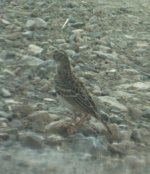Earnest lad
Well-known member
Please may I request advice. To be honest I posted this pic previously (4 years ago I think) : Some kind soul (more knowledgeable than myself) suggested Short-toed Lark.
However I continued to have doubts, hoping for a Calandara Lark lifer.
I seem to think the bill might be too big for short-toed and better for Calandra . Also I have seem some online photos of juv. Calandra lark that seem to be very like this bird. Still I stand ready to be corrected if necessary.
So if anyone might be able to offer some suggestions on this "cold case" LOL, I would be most appreciative.
Sorry for the poor quality of photo.
However I continued to have doubts, hoping for a Calandara Lark lifer.
I seem to think the bill might be too big for short-toed and better for Calandra . Also I have seem some online photos of juv. Calandra lark that seem to be very like this bird. Still I stand ready to be corrected if necessary.
So if anyone might be able to offer some suggestions on this "cold case" LOL, I would be most appreciative.
Sorry for the poor quality of photo.





